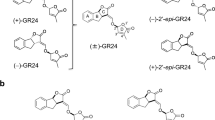Abstract.
Tobacco (Nicotiana tabacum L.) plants were grown with and without the arbuscular mycorrhizal fungus, Glomus intraradices Schenk & Smith. High-performance liquid chromatographic analyses of methanolic extracts from mycorrhizal and non-mycorrhizal tobacco roots revealed marked fungus-induced changes in the patterns of UV-detectable products. The UV spectra of these products, obtained from an HPLC photodiode array detector, indicated the presence of several blumenol derivatives. The most predominant compound among these derivatives was spectroscopically identified as 13-hydroxyblumenol C 9-O-gentiobioside (“nicoblumin”), i.e. the 9-O-(6′-O-β-glucopyranosyl)-β-glucopyranoside of 13-hydroxy-6-(3-hydroxybutyl)-1,1,5-trimethyl-4-cyclohexen-3-one, a new natural product. This is the first report on the identification of blumenol derivatives in mycorrhizal roots of a non-gramineous plant.
Similar content being viewed by others
Author information
Authors and Affiliations
Additional information
Received: 28 August 1998 / Accepted: 26 October 1998
Rights and permissions
About this article
Cite this article
Maier, W., Schmidt, J., Wray, V. et al. The arbuscular mycorrhizal fungus, Glomus intraradices, induces the accumulation of cyclohexenone derivatives in tobacco roots. Planta 207, 620–623 (1999). https://doi.org/10.1007/s004250050526
Issue Date:
DOI: https://doi.org/10.1007/s004250050526




